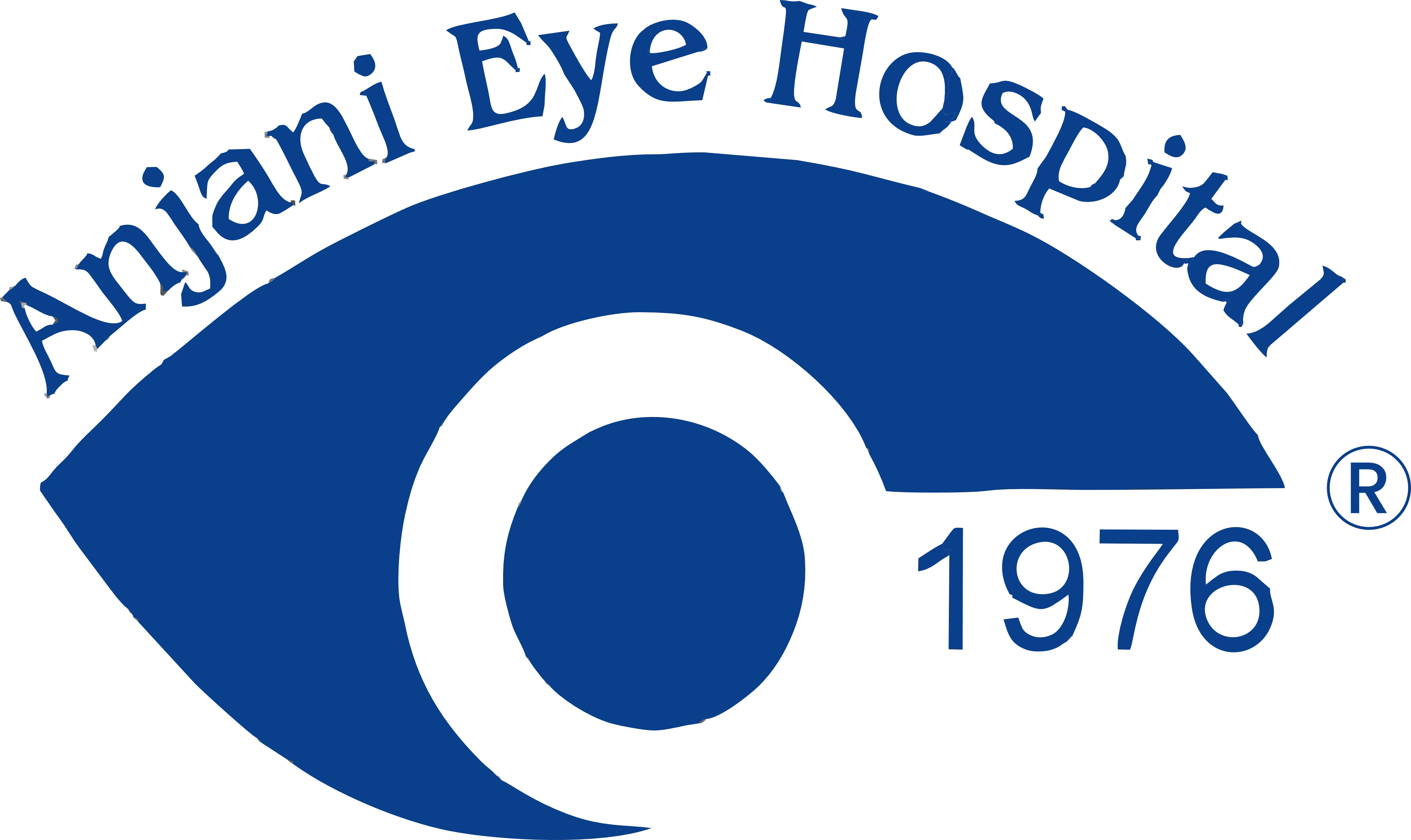Cataract
What is Cataract ?
The eye sees when light enters inside the eye, much like a photograph which is generated when light enters the camera. Inside your eye is a natural clear lens just like the lens of a camera. It focuses the light rays coming through the pupil on to the retina at the back of the eye, which in turn collects this light and sends a message to your brain, enabling you to see.
For the vision to be perfect, the lens should be clear so that the light can pass through it. Light enters through the cornea, passes through your natural lens and is focused on to your retina, resulting in clear vision.
Cataract is the clouding (opacification) of this natural lens, which prevents the light rays from reaching the retina. In early cataract, a change in glass power may help, but you may have fuzzy vision and difficulty while driving at night. But later on, it progressively affects vision till only perception of light remains (in mature cataract). Cataract is the leading cause of decreased vision.
Causes of Cataract
The most common cause of cataract is ageing (degenerative changes). As you age proteins in the natural lens degenerate, resulting in a clouded lens termed as a cataract. There might be other causes such as:
- Certain general conditions like diabetes and kidney disease.
- Certain ocular (eye) conditions like glaucoma, eye injuries, eye infections, or inflammations.
- Prolonged use of certain medications (steroids).
- In children, certain genetic or metabolic defects, infection and trauma are few causes
Symptoms of Cataract
You may experience some or all of the following symptoms, if you have cataract.
Faded colours of objects
Cloudy vision
Decreased vision at night
Coloured haloes
Difficulty in reading in dim light
Difficulty in driving at night (because of glaring of light)
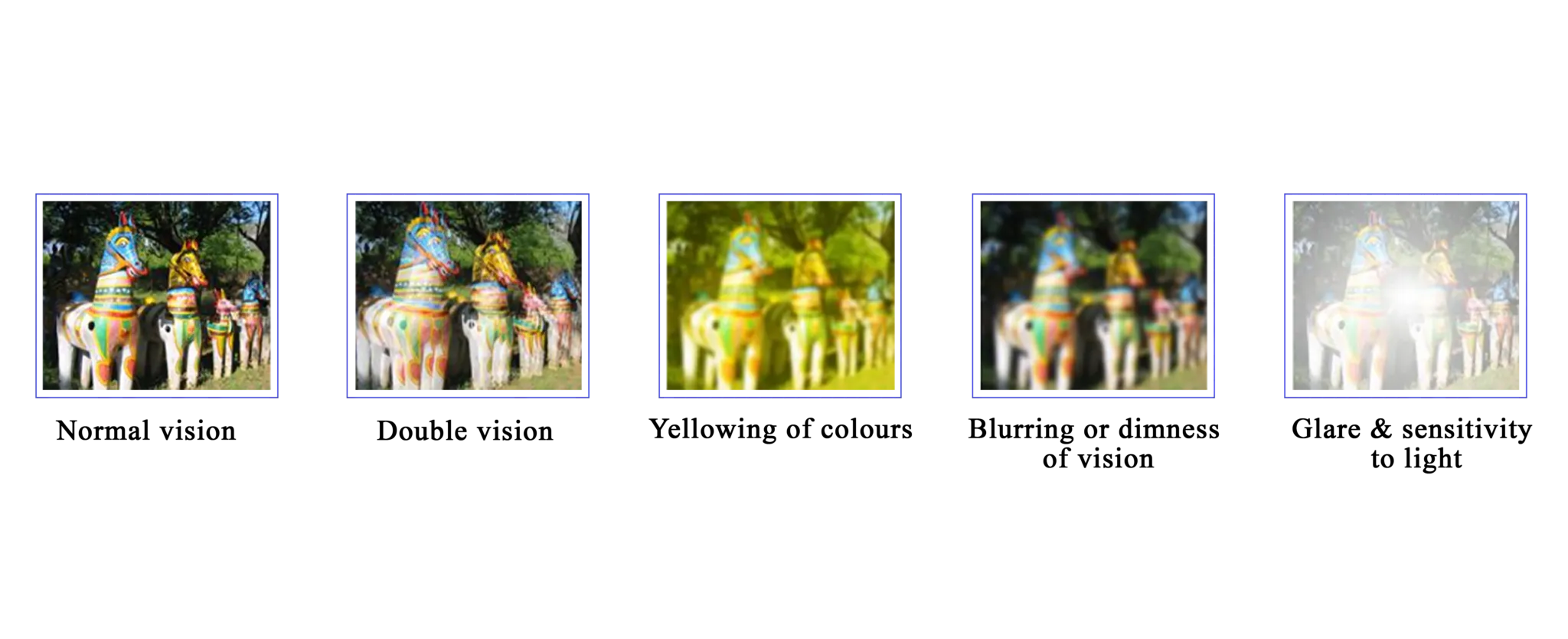
How can the Cataract be removed?
The only treatment for cataract is by surgical removal of the cloudy natural lens and replacing it with an artificial intra-ocular lens (IOL). The IOL helps the incoming light rays to focus on to your retina, thus enabling you to see clearly again. Your new lens should be able to restore vision to nearly what it was earlier (depending on your retinal and optic nerve function), though you may need to wear glasses for reading or driving. The options for IOLs include, MONO-FOCAL lenses – which corrects distance or near vision, and MULTI-FOCAL lenses – corrects vision for distance, intermediate and near. There is a third type of IOL called the TORIC (mono-focal / multi-focal) IOL – which corrects vision in eyes with astigmatism (distorted vision due to abnormal curvature of the eye).
What is the right timing for Cataract Surgery?
- To a large extent it depends on the profession of the person undergoing surgery.
1. If you are a regular computer user or a reader then you start feeling blurring of vision even in very early stages of cataract and you may need surgery early.
2. Some people don’t feel the need until their day-to-day activities don’t get hampered. - Whenever cataract affects vision to a degree that it hampers the person’s daily activities (reading, driving, playing any outdoor activities etc.), surgery should be considered.
What are the surgical techniques available for cataract surgery at Anjani Eye Hospital?
Anjani Eye Hospital is fully equipped with the most modern technology for performing suture-less cataract surgeries and achieving a perfect outcome. We have the world’s best phacoemulsification machines from Alcon viz., the Centurion Vision System (purely for phacoemulsification) and the Constellation Vision System (for vitrectomy and phacoemulsification). Both these machines can be used for the latest Micro-Coaxial Cataract Surgery (MICS), or removal of the cataract through a 1.8 to 2 mm incision with the implantation of foldable intraocular lenses (IOLs). We also offer all the kind of IOLs mentioned above.
- Manual surgery is not a surgical method of choice but is used in certain rare situations. In this the cataract is removed as a whole and rigid intraocular lens is then implanted in the eye in the end.
- SICS (Small Incision Cataract Surgery) is performed through 5- 6 mm wound and doesn’t require stitches..
- Extra capsular Cataract Extraction is done through a 9-10mm incision and it requires stitching of the wound.
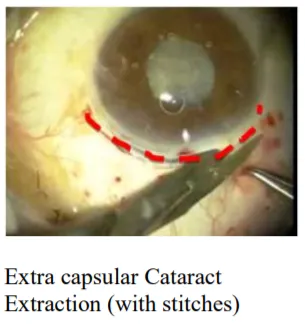
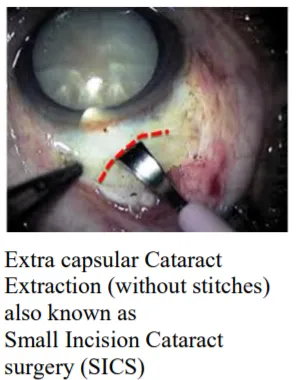
- Phacoemulsification is at present universally accepted as the standard of care for cataract surgery. Ultrasound energy is used in phacoemulsification to break up the cataract (emulsify) into smaller fragments, which can be sucked out of the eye by an automated vacuum pump. Micro Incision Cataract Surgery (MICS) or “Micro-coaxial Phacoemulsification” is a type of phacoemulsification of the cataract through a wound of 1.8 to 2.2 mm or less. A foldable intraocular lens is then implanted in the eye at the end, through the same incision. This needs a special machine and is technically advanced procedure needing surgical expertise.
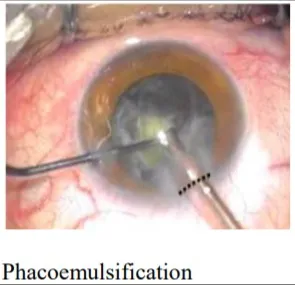
What are the various options of Intraocular lenses (IOLs) offered at Anjani Eye Hospital?
Once the cataract is removed by either of methods, an Intra Ocular Lens (IOL) is implanted in its place. IOLs can be either rigid (needing larger wound / incision size) or foldable (can be inserted through smaller wounds). The rigid lenses are made up of PMMA (Poly Methyl Methacrylate) material and the foldable lenses are made of either hydrophilic or hydrophobic acrylate material. Mono-focal IOLs: They can focus light rays from one particular distance only. Normally distance objects are clear and one needs glasses for reading. The majority of the IOLs implanted are mono-focal. Multifocal IOLs: Multifocal IOLs have different segments built onto the same lens, which allows clear distance & near vision with freedom from glasses/ spectacles for most activities. Toric IOLs: Traditionally used monofocal IOLs correct only the spherical refractive error. Patients with pre existing astigmatism will need spectacle correction for distance vision and near. Toric IOLs eliminates the need of glasses for distance in these set of patients. Recently multifocal IOLs have also been introduced with this option, thus correcting for distance, near and cylindrical error. Toric Multifocal IOLs: People with astigmatism were earlier not suitable for multifocal IOLs. Now with the introduction of Toric Multifocal IOLs, it is possible to correct this astigmatism and also provide good near vision to this group of people.
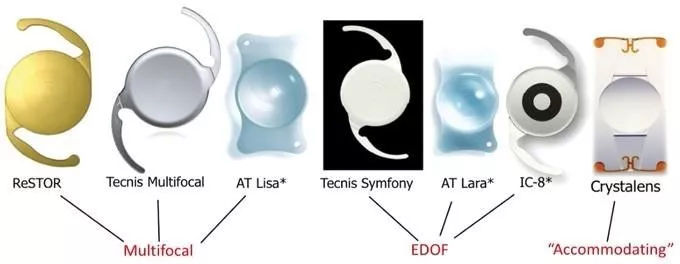
What are the recent advances in the surgical management of Cataract?
Femtosecond Laser Assisted cataract surgery (blade-less cataract surgery)
In standard phacoemulsification, the corneal incisions are made with a metal blade. The circular opening in the lens capsule from which to remove the cataract and place an artificial lens is made using a sharp bent needle. The surgeon then divides the lens by various techniques using phacoemulsification probe (instrument) and later removes these pieces by breaking them down further using ultrasound energy. In blade-less cataract surgery with femtosecond laser, the entire process is automated using the machine’s integrated OCT guided imaging system. Since the surgery is done with laser, the incisions are more precise and the capsular opening is perfectly centered and round. This allows for exact placement of the artificial lens implant optimizing visual outcomes. This is of utmost importance in premium intraocular lenses such as aspheric design IOLs, Toric IOLs and Multifocal IOLs where the slightest error can compromise the quality of vision. Moreover, as the laser divides the lens into small fragments, the amount of ultrasound energy used to remove the cataract is greatly reduced, which in turn helps in early visual recovery. The additional advantage of this laser is that it is accurate enough to plan incisions in the peripheral cornea to aid in the correction of pre-existing corneal astigmatism (cylindrical power). The femtosecond laser is the latest breakthrough in advanced cataract surgery as a means to providing precision and safety to crucial steps of the surgery.
What are the benefits of Cataract Surgery?
- Improvement in sight and colour vision
- Improvement in quality of life
- Improvement of clarity of vision
- No need or decreased dependence on glasses
What are the preoperative requirements?
One needs to be in fairly good general health.
Diabetes, hypertension, and cardiac problems (if any) need to be controlled before surgery.
One needs to do a detailed checkupof the eye and a dilated examination of the retina.
- Specific to the eye, one needs to undergo scans of the eye to find out the curvature and the length of the eye to decide on the model and power of the intraocular lens to be implanted.
What happens on the day of surgery?
Surgery is a “walk-in, walk-out” or a “day care” procedure.
- Surgery is mostly done under topical anesthesia. Anesthetic drops numb the surface of the eye and the surgery can be comfortably and painlessly performed.
- Some patients may require an anaesthetic injection before the surgery.
- A routine surgery lasts approximately 10 minutes with the preparation time being of similar duration.
- Pre-operatively dilating drops are applied which take between 1 – 1.5 hours to act.
- One could expect to spend 5 – 6 hrs at the hospital on the day of surgery.
How long does the lens implanted in the eye last?
- During surgery the normal lens of the eye is removed and replaced with an intra-ocular lens, which lasts for the entire lifetime.
Is there much discomfort after surgery?
- Cataract surgery is pretty much painless and so is the post-operative period. There is mild irritation (or foreign body) sensation for a few days. There may be mild redness & watering of the eyes, which again subside in a few days.
What do I do after surgery?
- There is no need for bed rest after surgery. One can walk, eat normally, watch TV and be normal around home the next day of the surgery. One needs some protective glasses only when outdoors.
What about the post-operative treatment?
- There is a graded schedule for eye drops after surgery, which would be stopped over a period of 4 to 6 weeks.
When can I resume my normal work?
- One can resume work even the day after surgery. One could either work from home or office, but one should remember to apply the drops as advised and avoid dusty or dirty environments. Normally till the glass correction is given 4-6 weeks after surgery, reading may be difficult, but this is much better after implantation of a multifocal IOL. Temporary glasses can be given the day after surgery.
What are the post-operative restrictions?
One should avoid water directly getting into the eyes for 7- 10 days after surgery.
One could sponge the hair and face properly even the day after surgery.
Normal bathing below neck level (taking precautions for the eye) can be resumed the day after surgery.
After 7- 10 days one can be completely normal.
Bending down, chewing food or lifting moderate weights are not at all a problem after surgery.
One can be pretty much normal after surgery.
When will I see well?
- The vision will be bright and pretty much clear the day after surgery, provided the retina is normal. Full vision will be restored gradually in a few days time.
Objects may appear excessively bright & blue in colour for some days. This is because the cataract was not allowing light to reach the retina and most of the blue light was being cut off. The brain gets disused to seeing blue. All these complaints are temporary.
Will I need glasses after surgery?
- We use highly specialized equipment (Immersion A-Scan, Optical Biometry, corneal topography etc.) to predict the IOL power to be implanted, So that post operatively the patient can see clearly without glasses. Even then, there is a small possibility of a minor computational certain patient requiring residual spectacle power, which would need to be corrected with glasses.
How do I clean my eye after surgery?
- One would not normally need to specifically clean the eye after surgery. If there are deposits of medicines on the eyelids or lashes one could use sterile eye wipes which are commercially available and clean the outside of the eyelids (and lashes) with them. Since we cannot apply water on to the face, using wet wipes or mopping the face with a wet towel (with the eyes closed) should suffice to clean the rest of the face for a week.
Can I travel after surgery?
- Any amount of travel is absolutely fine provided one remembers to apply the eye drops. Timings will be given for the application of the eye drops, but an hour
this way or that does not cause any problem.
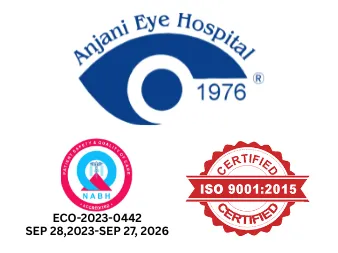
Contact
Address: 20, Farmland, Central Bazar Road, Near Lokmat Square, New Ramdaspeth, Nagpur – 440010, Maharashtra, India. Phone:+91 712 2425 839/2425 869/2425 899 For Appointment:+91 78755 20005 WhatsApp:+91 78755 10002 Email:anjanieyehospital1976@gmail.com Hospital Working Hours: 7:30 AM – 5:30 PM (Monday to Friday) 7:30 AM – 3:30 PM (Saturday) Sunday Closed
Copyright © 2025. All rights reserved. Built by SHOUT IN & OUT
Privacy Policy
